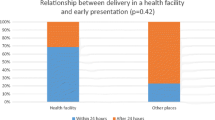Abstract
Introduction
Management of spina bifida is a complex issue with various systems of the body involved either directly or indirectly.
Discussion
Deformities of the bone and joints (especially spine and lower limbs) play a significant role in causation of deficits in the child. Management of these deficits require a focused, specialised and multidisciplinary approach with orthopaedician, physiotherapist, intensivist and psychologist apart from neurosurgeon playing an important part. To manage these deformities, one needs to understand the pathophysiology of causation of these defects. The corrective surgical intervention ranges from a simple release of contracture to highly complex spinal instrumentations.
Conclusion
We reviewed the literature and have shared our experience on this aspect of spina bifida.




Similar content being viewed by others
References
Mclone DG, DiasLS, Kaplan WE (1984) Concepts in management of spina bifida. In: Concepts of paediatric neurosurgery, Vol 5: S Karger, Basel
Menelaus MB (1980) The orthopaedic management of spina bifida cystica. Churchill Livingstone, Edinburgh
Swaroop VT, Dias L (2009) Orthopedic management of spina bifida. Part I: hip, knee, and rotational deformities. J Child Orthop 3:441–449
Guille JT, Sarwark JF, Sherk HH, Kumar SJ (2006) Congenital and developmental deformities of the spine in children with myelomeningocele. J Am Acad Orthop Surg 14:294–302
Dias LS The orthopaedic aspects of spinal dysraphism. In: The Paediatric spine I: Development and the dysraphic state
Mayfield JK Comprehensive orthopaedic management in myelomeningocele. In: Comprehensive management of spina bifida
Neuromuscular disorders (2008) In: Herring J (ed) Tachdjian’s pediatric orthopaedics. Saunders Elsevier, Philadelphia, pp 1405–1453
McDonald CM, Jaffe KM, Mosca VS, Shurtleff DB (1991) Ambulatory outcome of children with myelomeningocele: effect of lower-extremity muscle strength. Dev Med Child Neurol 33:482–490
Pillard D, Massy P, Taussing G (1981) The hip in myelomeningocele. Orthop Trans 5:61
Banta JV, Whiteman S, Dyck RM, Hartleip D, Gilbert D (1976) Fifteen years review of myelodysplasia. J Bone Joint Surg 58A:726
Hall JE, Martin R (1970) The natural history of spine deformity in myelomeningocele. A study of 130 patients. Proc Can Orthop Assoc. Bermuda, June 1970
Mackel JL, Lindseth RE (1975) Scoliosis in myelodysplasia. J Bone Joint Surg 57A:1031
Moe JK, Winter RB, Bradford DS, Lonstein JE (1987) Scoliosis and other spinal deformities. Saunders, Philadelphia
Piggott H (1980) The natural history of scoliosis in myelodysplasia. J Bone Joint Surg 62B(1):54–58
Shurleff DB, Bourney R, Gordon LH, Livermore N (1976) Myelodyspalsia: the natural history of kyphosis and scoliosis. A preliminary report. Dev Med Child Neurol 18(Suppl 37):126–133
Lindseth R (2001) Myelomeningocele spine. In: Weinstein S (ed) The pediatric spine: principles and techniques, 2nd edn. Lippincott Williams and Wilkins, Philadelphia, pp 845–868
Sriram K, Bobetchko K, Hall J (1972) Surgical management of spinal deformities in spina bifida. J Bone Joint Surg Br 54:666–676
Osebold WR, Mayfield JK, Winter RB, Moe JH (1982) Surgical treatment of the paralytic scoliosis associated with myelomeningocele. J Bone Joint Surg 64A:841–856
Mazur J, Menelaus MB, Dickens DR et al (1986) Efficacy of surgical management for scoliosis in myelomeningocele: correction of deformity and alteration of functional status. J Pediatr Orthop 6:568–575
Banit DM, Iwinski HJ Jr, Tawalkar V et al (2001) Posterior spinal fusion in paralytic scoliosis and myelomeningocele. J Pediatr Orthop 21:117–125
Basobas L, Mardjetko S, Hammerberg K et al (2003) Selective anterior fusion and instrumentation for the treatment of neurovascular scoliosis. Spine 28:S245–S248
Dunn H (1983) Kyphosis of myelodysplasia: operative treatment based on pathophysiology. Orthop Trans 7:19
Nolden MT, Sarwark JF, Vora A et al (2002) A kyphectomy technique with reduced peri-operative morbidity for myelomeningocele kyphosis. Spine 27:1807–1813
Heydemann JS, Gillespie R (1987) Management of myelomeningocele kyphosis in the older child by kyphectomy and segmental spinal instrumentation. Spine 12:37–41
Hall JE, Poitras B (1977) The management of kyphosis in patients with myelomeningocele. Clin Orthop Relat Res 128:33–40
Feiwell E, Sakar D, Blatt T (1978) The effect of hip reduction on function in patients with myelomeningocele: potential gains and hazards of surgical care. J Bone Joint Surg 60A:169
Lindseth RE(1990) Myelomeningocele. In: Paediatric Orthopaedics. Vol 1, ed 3
Lindseth RE (1976) Treatment of the lower extremity in children paralysed by myelomeningocele. Instr Course Lect 25:76–82
Parsch K, Manner G (1976) Prevention and treatment of knee problems in children with spina bifida. Div Med Child Neurol 18(6):114
Selber P, Dias L (1998) Sacral-level myelomeningocele: longterm outcome in adults. J Pediatr Orthop 18:423–427
Noonan KJ, Didelot WP, Lindseth RE (2000) Care of the pediatric foot in myelodysplasia. Foot Ankle Clin 5(2):281–304
Swaroop VT, Dias L (2011) Orthopaedic management of spina bifida—part II: foot and ankle deformities. J Child Orthop 5:403–414
Gerlach DJ, Gurnett CA, Limpaphayom N, Alaee F, Zhang Z, Porter K, Kirchhofer M, Smyth MD, Dobbs MB (2009) Early results of the Ponseti method for the treatment of clubfoot associated with myelomeningocele. J Bone Joint Surg Am 91(6):1350–1359
Flynn JM, Herrera-Soto JA, Ramirez NF, Fernandez-Feliberti R, Vilella F, Guzman J (2004) Clubfoot release in myelodysplasia. J Pediatr Orthop B 13:259–262
Kodros SA, Dias LS (1999) Single-stage surgical correction congenital vertical talus. J Pediatr Orthop 19(1):42–48
Park KB, Park HW, Joo SY, Kim HW (2008) Surgical treatment of calcaneal deformity in a select group of patients with myelomeningocele. J Bone Joint Surg Am 90(10):2149–2159
Westcott MA, Dynes MC, Remer EM, Donaldson JS, Dias LS (1992) Congenital and acquired orthopedic abnormalities in patients with myelomeningocele. Radiographics 12:1155–1173
Dias L (2004) Orthopaedic care in spina bifida: past, present, and future. Dev Med Child Neurol 46:579
Author information
Authors and Affiliations
Corresponding author
Rights and permissions
About this article
Cite this article
Kumar, R., Mehrotra, A. & Banerjee, S. Neuro-orthopaedic conditions in spina bifida: natural course and their management and long-term outcomes. Childs Nerv Syst 29, 1581–1587 (2013). https://doi.org/10.1007/s00381-013-2146-0
Received:
Accepted:
Published:
Issue Date:
DOI: https://doi.org/10.1007/s00381-013-2146-0




